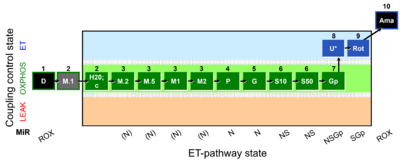Description
Reference: A - SUIT-038 - ...
SUIT number: D091_1D;2M.1;2H2O;2c;3M.2;3M.5;3M1;3M2;4P;5G;6S10;6S50;7Gp;8U;9Rot;10Ama
O2k-Application: O2
The SUIT-038 O2 mt D091 protocol is focused on the analysis of the malate anaplerotic pathway control state in mitochondrial preparations such as isolated mitochondria, tissue homogenates and permeabilized cells (already permeabilized when they are added to the chamber) in a wide variety of species, tissues and cell types. Malate alone does not support respiration if oxaloacetate is not metabolized further in the absence of acetyl-CoA. The careful titration of malate is required to analyze the activity of the mt-isoform of NADP- or NAD(P)-dependent malic enzyme (mtME). If these enzymes are present in the sample one should be able to reach with malate alone a high respiratory activity comparable to the NADH-linked pathway control states with more classical combinations of substrates (e.g. PM or GM). Moreover, the pathway control in OXPHOS state ((N), N, NS, NSGp pathways) and in ET state (NSGp and SGp) can be evaluated by using this SUIT protocol.
Communicated by Doerrier C and Gnaiger E (last update 2019-09-24)
Representative traces
Steps and respiratory states
| Step | State | Pathway | Q-junction | Comment - Events (E) and Marks (M) |
|---|---|---|---|---|
| 1D | ROX | 1D
| ||
| 2M.1 | 1D;2M.1 | |||
| 2H2O | 1D;2M.1;2H2O
| |||
| 3c | 1D;2M.1;2H2O;2c
| |||
| 3M.2 | 1D;2M.1;2H2O;2c;3M.2
| |||
| 3M.5 | 1D;2M.1;2H2O;2c;3M.2;3M.5
| |||
| 3M1 | 1D;2M.1;2H2O;2c;3M.2;3M.5;3M1
| |||
| 3M2 | 1D;2M.1;2H2O;2c;3M.2;3M.5;3M1;3M2
| |||
| 4P | PMP | N | CI | 1D;2M.1;2H2O;2c;3M.2;3M.5;3M1;3M2;4P
|
| 5G | PGMP | N | CI | 1D;2M.1;2H2O;2c;3M.2;3M.5;3M1;3M2;4P;5G
|
| 6S10 | PGMSP | NS | CI&II | 1D;2M.1;2H2O;2c;3M.2;3M.5;3M1;3M2;4P;5G;6S10
|
| 6S50 | PGMSP | NS | CI&II | 1D;2M.1;2H2O;2c;3M.2;3M.5;3M1;3M2;4P;5G;6S10;6S50
|
| 7Gp | PGMSGpP | NSGp | CI&II&GpDH | 1D;2M.1;2H2O;2c;3M.2;3M.5;3M1;3M2;4P;5G;6S10;6S50;7Gp
|
| 8U | PGMSGpE | NSGp | CI&II&GpDH | 1D;2M.1;2H2O;2c;3M.2;3M.5;3M1;3M2;4P;5G;6S10;6S50;7Gp;8U
|
| 9Rot | SGpE | SGp | CII&GpDH | 1D;2M.1;2H2O;2c;3M.2;3M.5;3M1;3M2;4P;5G;6S10;6S50;7Gp;8U;9Rot
|
| 10Ama | ROX | 1D;2M.1;2H2O;2c;3M.2;3M.5;3M1;3M2;4P;5G;6S10;6S50;7Gp;8U;9Rot;10Ama
|
- Bioblast links: SUIT protocols - >>>>>>> - Click on [Expand] or [Collapse] - >>>>>>>
- Coupling control
- Pathway control
- Main fuel substrates
- » Glutamate, G
- » Glycerophosphate, Gp
- » Malate, M
- » Octanoylcarnitine, Oct
- » Pyruvate, P
- » Succinate, S
- Main fuel substrates
- Glossary
Strengths and limitations
- SUIT-002 in combination with SUIT-001 provides a common reference for comparison of respiratory control in a large variety of species, tissues and cell types. Both SUIT protocols provide a mitochondrial mapping which allows:
- 1. to obtain reference values.
- 2. to evaluate mitochondrial physiological diversity, generating a mt-database on comparative mitochondrial physiology.
- 3. to screen specific defects.
- SUIT-001 and SUIT-002 are used in the MitoFit Proficiency test for inter-individual and inter-laboratory reproducibility quality control.
- A succinate concentration of >10 mM may be required for saturating SE capacity.
- + SUIT-002 allows the depletion of endogenous substrates with ADP (1D).
- + The protocol provides information on F-pathway in OXPHOS state. The low concentration of malate used in this protocol, typically 0.1 mM, does not saturate the N-pathway; but saturates the F-pathway.
- + F-pathway (3Oct-2M.1) can be compared to FN-pathway (5P) in OXPHOS state.
- + Pathway control in OXPHOS (F, F(N), FN, FNS, FNSGp pathways) and in ET state (FNSGp and SGp) can be observed.
- + Harmonization with SUIT-001 allows to perform both SUIT protocols in parallel. The cross-linked respiratory states can be statistically used as repeated measurements.
- + Harmonization with many SUIT protocols (up to step 7S).
- + In SUIT-002, the full set of pathways converging into Q (FNSGp) is obtained in OXPHOS and ET states. Therefore, P/E (8Gp/9U) at high ET capacity can be calculated.
- + This protocol can be extended with the Complex IV module.
- - S-pathway in ET state is not obtained (it is obtained in SUIT-001).
- - Lengthy duration of the experiment.
- - We do not generally recommended the addition of already permeabilized cells, but we recommend to perform the permeabilization of the cell plasma membrane in the chambers (see SUIT-002 O2 ce-pce D007).
Compare SUIT protocols
- SUIT-001 O2 mt D001 (RP1): Harmonized SUIT protocol for isolated mitochondria, tissue homogenate and permeabilized cells (already permeabilized).
- SUIT-002 O2 ce-pce D007: SUIT-002 for non-permeabilized cells. Permeabilization of the cell plasma membrane occurs in the chambers through digitonin addition. Therefore, SUIT-002 O2 ce-pce D007 protocol provides information of non-permeabilized cell respiration (ce) and permeabilized cell respiration (pce).
Chemicals and syringes
| Step | Chemical(s) and link(s) | Comments |
|---|---|---|
| 1D | ADP (D) | |
| 2M.1 | Malate (M) | |
| 2H2O | ||
| 2c | Cytochrome c (c) | |
| 3M.2 | Malate (M) | |
| 3M.5 | Malate (M) | |
| 3M1 | Malate (M) | |
| 3M2 | Malate (M) | |
| 4P | Pyruvate (P) | |
| 5G | Glutamate (G) | |
| 6S10 | Succinate (S) | |
| 6S50 | Succinate (S) | |
| 7Gp | Glycerophosphate (Gp) | |
| 8U | Carbonyl cyanide m-chlorophenyl hydrazone, CCCP (U) | Can be substituted for other uncoupler |
| 9Rot | Rotenone (Rot) | |
| 10Ama | Antimycin A (Ama) |
- Suggested stock concentrations are shown in the specific DL-Protocol.


